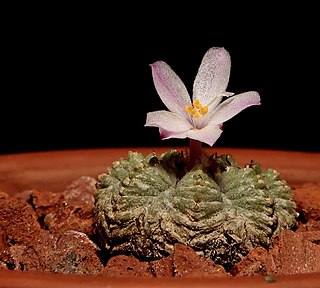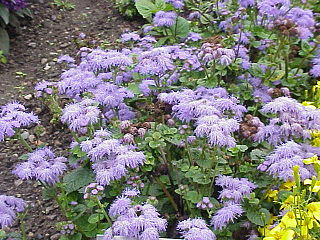Related Research Articles

Sechium is a genus in tribe Sicyoeae of the gourd family, Cucurbitaceae. Its best known member is the edible and widely cultivated chayote.

The genus Aztekium contains two species of small globular cactus. Discovered in 1929 by F. Ritter, in Rayones, Nuevo León, Mexico, this genus was thought to be monotypic until a second species was discovered by George S. Hinton, in Galeana, Nuevo León in 1991. A further possible species, Aztekium valdezii, was described in 2011, but is considered to be a synonym of A. ritteri.

Sebastiania is a genus of flowering plants in the family Euphorbiaceae first described in 1821. It is native to North and South America from Arizona and the West Indies south to Uruguay.

Eupatorieae is a tribe of over 2000 species of plants in the aster family. Most of the species are native to tropical, subtropical, and warm temperate areas of the Americas, but some are found elsewhere. Well-known members are Stevia rebaudiana, a number of medicinal plants (Eupatorium), and a variety of late summer to autumn blooming garden flowers, including Ageratum (flossflower), Conoclinium (mistflower), and Liatris.
Quercus hintonii is an rare Mexican species of tree in the beech family. It is endemic to the State of México in the central part of the Republic of Mexico.
Utricularia hintonii is a small terrestrial carnivorous plant that belongs to the genus Utricularia. U. hintonii is an annual lithophyte that is endemic to Mexico and is only known from the type location about 160 kilometres (160,000.0 m) west-southwest of Mexico City. It was originally collected by G. B. Hinton on June 10, 1933 and described as a new species by Peter Taylor in 1986, who named it in honor of Hinton.

Pittocaulon is a genus of Mexican shrubs and small trees in the groundsel tribe within the sunflower family.

Zeugites is a genus of North American plants in the grass family. Its species are native to the Caribbean, Mexico, Central America, and/or South America.
Alomia is a genus of flowering plants in the daisy family, Asteraceae, described as a genus in 1818.
Decachaeta is a genus of Mesoamerican flowering plants in the sunflower family.
Mexianthus is a genus of Mexican flowering plants in the boneset tribe within the sunflower family.
Microspermum is a genus of Mexican flowering plants in the boneset tribe within the sunflower family.
Neohintonia is a genus of flowering plants in the boneset tribe within the sunflower family.

Piqueria is a genus of Caribbean and Mesoamerican plants in the boneset tribe within the sunflower family.
Revealia is a genus of Mexican plants in the boneset tribe within the sunflower family. The only known species is Revealia macrocephala, native to the Mexican State of Guerrero.

Hilaria is a genus of North American plants in the grass family. Members of the genus are commonly known as curly mesquite. They are found in the Southwestern United States, Mexico, and Guatemala.
Cymophora is a genus of flowering plants in the aster family. All known species are native to Mexico.

Deppea is a genus of flowering plants in the family Rubiaceae. The genus is found in Mexico, Central America and from Brazil to northeastern Argentina.
Rhodochiton hintonii is a climbing or sprawling herbaceous perennial native to the state of Guerrero in Mexico. It has dangling flowers, with a bell-shaped calyx and dark purple petals forming a tube. Unlike the better known Rhodochiton atrosanguineus, the petal tube is asymmetrical with two "lips".
Sebastiania hintonii is a species of flowering plant in the family Euphorbiaceae. It was described in 1960. It is native to central and southwestern Mexico.
References
- ↑ The International Plant Names Index
- ↑ D.J.N.Hind & H.E.Robinson. 2007. Tribe Eupatorieae In: The Families and Genera of Vascular Plants vol.VIII. (Joachim W.Kadereit & Charles Jeffrey, volume editors. Klaus Kubitzky, general editor). Springer-Verlag. Berlin, Heidelberg.
- ↑ Grashoff, Jerold Lee. 1975. Brittonia 27(1): 69-73
- 1 2 Tropicos, Metastevia Grashoff
- ↑ The Plant List, Metastevia hintonii Grashoff